|

by Dr. Friedemann Freund
NASA Ames Research Center,
San Jose State University, SETI Institute
May 2016
from
HeartMath Website

Earth is a dynamic body, tectonically active, with gigantic forces
pushing and pulling the plates around, piling up mountain ranges and
opening ocean basins.
What has not been recognized for a very
long time is that as those tectonic forces stress the rocks deep in
the earth they turn into batteries from which electric currents can
flow out and charge the earth's crust.
It has become increasingly clear that
this process - rocks turning into batteries - is crucial to our
understanding of the complex signals the earth sends out before
major earthquakes.
"Rock batteries" are different, however, from the common
electrochemical batteries that come in many shapes and sizes and
which are used in everyday life.
When rocks are stressed, something very
unique happens that has no equivalent process in electrochemical
batteries:
In rocks, electrons and what are
called "holes" become activated under pressure, similar to
charges that occur in transistors - a process that is well
understood in semiconductor physics.
Most everybody knows what electrons are:
the negatively charged elemental
particles that carry currents through copper and other metal
wires.
Electrons can flow through the wires and
be pulled out to form electron beams that will travel through a
vacuum, as they did in the cathode ray tubes used in TVs before flat
screens were developed.
Holes are different. They are what physicists call pseudo-particles
and they exist only in solids. They are places in a solid such as a
rock where an electron is missing in the atomic structure.
Hence, holes are defect places where
electrons should be. They create a positive charge relative to their
surroundings.
Most minerals in rocks contain atomic defects in their otherwise
orderly crystallographic structures.
In these structures, pairs of oxygen
anions (negatively charged ions that migrate to positive charges)
exist that have changed their energy levels from the usual two
electrons to the unusual one electron - from O2-
to O-.
Most of the time these O- pairs are tied
together closely in the form of peroxy defects, innocuous and
electrically inactive.
However, when rocks are stressed, some
of these peroxy defects break up. They produce an electron that
becomes trapped in the holes left by the broken peroxy bonds,
resulting in a highly mobile positive charge carrier, capable of
letting currents flow out of the stressed-rock volume. These
currents can travel fast and far.
Because of their unusual properties, these holes, which are
associated with minerals containing O- in a matrix of O2-,
have been given a special name: positive holes, sometimes
abbreviated as p-holes.
When rocks are stressed deep in the earth's crust, p-holes are
generated, leading to active current flows.
The p-holes flow out of the
stressed-rock volume at an initial speed of about 100 meters per
second, spreading into the surrounding less-stressed or unstressed
rocks and traveling distances on the order of kilometers, even tens
of kilometers.
When they arrive at the earth's surface,
they can cause a number of effects.
For instance, when they flow into water,
they can strip electrons off water molecules forming hydrogen
peroxide, which can affect dissolved organics through partial
oxidation.
When they O- accumulate at the solid
earth's surface, they set up potential differences between the
earth's surface and the subsurface. Trees can sense the electric
potentials through their root systems, which is why I am
collaborating with the HeartMath Institute Research Center to
measure changes in tree and ground potentials.
When the p-holes accumulating at the
surface increase, they start to recombine, returning to the peroxy
state.
In the process, they emit infrared
photons that satellites can pick up as thermal infrared (TIR),
which can make it appear as if the earth's surface is heating up
while in reality the effect is the result of a non-thermal infrared
emission caused by the recombination of O- pairs to form peroxy
bonds.
At the same time, large electric fields are building up at the
earth's surface that are strong enough to ionize the air at the
ground-to-air interface, injecting massive amounts of positive ions
into the lower atmosphere.
These air-ionization events often occur
in pulses, sending pressure waves upward through the atmosphere that
can propagate all the way up to the ionosphere, causing what are
called acoustic gravity waves (AGW) at frequencies too low
for humans to hear.
Additionally at the same time, what is basically an air bubble laden
with positive ions also expands upward, through the troposphere to
the edge of the stratosphere.
From there, the positive ions continue
to rise, drifting farther, through the mesosphere. In response,
electrons in the ionosphere are pulled down, causing perturbations
in the ionospheric electric field, described as "turbulences," and
changes in the total electron content, known as TEC anomalies.
TEC anomalies are being evaluated around
the clock and around the globe as part of the heightened interest in
space weather and in pre-earthquake science.
With everything seeming so clear-cut and basically well understood,
the question arises:
Why isn't the pre-earthquake
rock-battery science a well-established discipline by now?
The answer is:
Even though the rock-battery concept
seems conceptually simple and intuitively easy to understand, it
is enormously complex.
The complexity lies in understanding how
the electric circuit is completed or closed in the process of
achieving the sustained current outflow - enabled because of p-holes
- from any stressed rock deep in the earth's crust.
For the rock battery to work, the
outflow of a certain number of positive-charge carriers that leave
the stressed rocks deep in the earth has to be balanced by an
outflow of an equal or nearly equal number of negative charges.
Well, that's the essence of any battery.
In an electrochemical
battery, for instance, metal ions flow through the body of the
battery, from the anode (positive) to the cathode (negative), while
the same number of electrons that flow through the outer circuit via
electric wire also flow from the anode to the cathode.
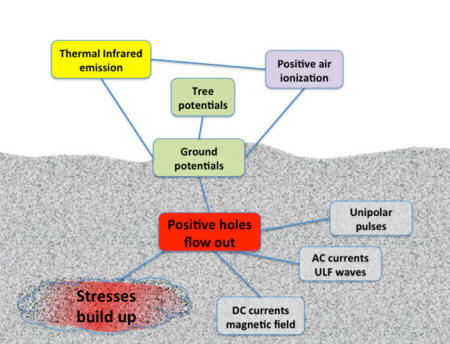
When rocks are stressed, defects that exist in an inactive state in
their constituent minerals become activated.
They turn into electron-hole pairs, of
which the holes, called "positive holes", have the remarkable
ability to flow out of the stressed rock volume. They can travel
fast (up to 100 m/s) and far (easily tens of kilometers).
On the way and upon arrival at the
Earth's surface, they cause a multitude of reactions, which produce
some form of signals that we can detect. Changes in the ground
potential and surface/subsurface electric fields among them, but
also changes in the spring water, well water, ground water
chemistry.
Interestingly, trees seem to be
excellent antennae to sense the electric field between their roots
and their trunks or branches.
In nature, deep in the earth's crust, p-holes have no problems
flowing out of any stressed rock, spreading into the surrounding
less-stressed or unstressed rocks.
However, for reasons that are rather
well understood, though a bit too complicated to explain here,
electrons cannot follow suit.
They may be highly mobile within
stressed rocks, but outside, in unstressed rocks, their mobility is
severely restricted. Hence, the rock-battery circuit may not close
at all, may partially close or may require special conditions for
the circuit to close.
Indeed, much of the controversy that has raged for decades over the
question of whether pre-earthquake signals exist probably stems from
the fact that as long as there was no rock-battery concept, the
discussions over pre-earthquake signals suffered from lack of an
objective scientific basis.
Tree Experiment in Featured Research.
The Science of
Interconnectivity
The Research
Center is currently focusing on studying
different types of interconnectivity between
people and the earth's magnetic fields.
We are following
up on a study that involved 1,600 Global
Coherence Initiative members that found a
number of significant effects of solar and
geomagnetic activity on people's mental
functions and emotional states.
Human-Earth
Connectivity
Currently, we
are analyzing data from two groups of
participants that wore heart rate
variability (HRV) recorders over long time
periods to determine how solar and Earth
magnetic fields affect human nervous-system
functioning.
The results of
these studies are showing that people are
indeed affected by Earth's energetic
environment, though in different ways.
We have been
surprised by several of the findings and
expect there to be more surprises as we
continue this research.
One surprise was
that when several of the sun and Earth's
energetic measures increased, the effect on
participants' nervous systems was positive:
Mental
clarity increased and they felt better.
An even more
surprising finding from the data was an
indication that humans apparently are linked
together and synchronizing at a deep level
to an external signal in Earth's magnetic
field environment.
These studies
should be published in early 2015, but we
are already planning the next phase of the
research.
We hope to raise
funds to conduct a multisite
interconnectedness study with groups of
participants located in four locations
around the globe where we have Global
Coherence Monitoring System sensor sites:
Participants at
each location will be coordinated to record
their HRV at the same time.
This will allow
us to verify the synchronization between
participants and Earth and how it is
accruing both locally and globally.
Tree Research
Another part of
our interconnectivity research is measuring
the electrical activity of trees and, more
generally, the ground.
We have spent
the past couple of years researching and
developing reliable methods and equipment to
measure tree potentials, and recently, we
also began measuring ground potentials.
Trees have a
surprisingly complex range of
electrical activity
and rhythms. They clearly have
circadian rhythms and other slower rhythms
as well as other activity that changes
faster.
They are coupled
in part to electrical potentials that we see
waxing and waning with the sun and moon's
gravitational pull on the earth.
We also will be
conducting experiments to see if and how
trees respond to human emotions, along the
lines of what has been demonstrated with
plants.
Another rather
amazing observation has been that some of
the longer-term trends in tree recordings
seem to respond to the approach of
earthquakes.
NASA Ames
scientist Friedemann Freund, with
whom we are collaborating,
has developed a theory
that explains how rocks deep in the earth
act as batteries when they are stressed by
tectonic forces preceding earthquakes.
The theory also
explains how the electrical charge carriers
that flow through the rocks appear to cause
a response in the electrical activity of
trees.
Amazingly, the
tree potential changes occur well before the
earthquakes actually happen. It may very
well be that trees will end up playing the
role of low-cost sensors that can help
predict when larger earthquakes are about to
occur.
With additional
funding, we hope to be able to expand this
line of research and set up a network of
tree-monitoring sites and create a website
that provides the public with live data from
a grove of redwood tress with which they can
try to interact energetically anytime they
like.
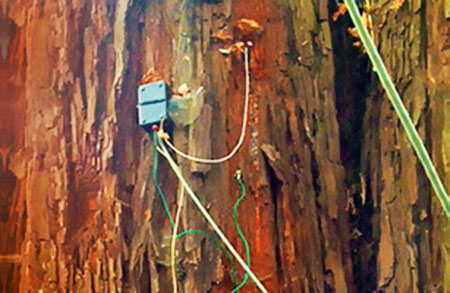
Setting sensors on trees
Electrodes attached to a Redwood tree.
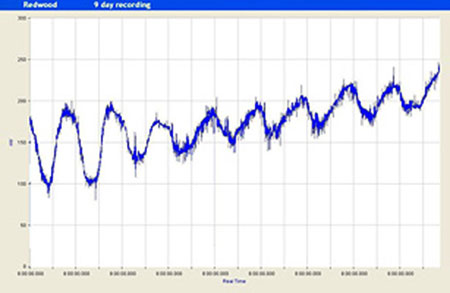
9-day reading
Electrical potentials of a Redwood tree over
9 days.
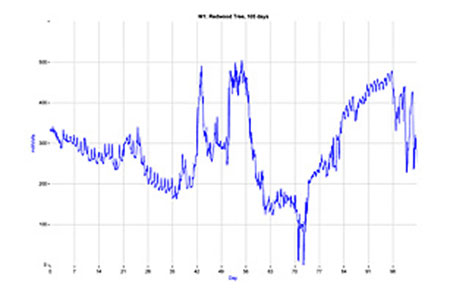
105-day activity report
Electrical potentials
of a Redwood tree over 105 days.
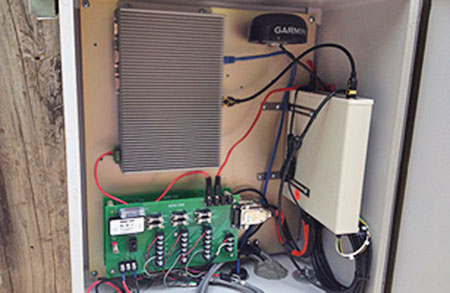
Our tree sensor
High resolution data acquisition equipment
used for monitoring trees.
|







